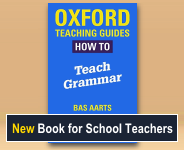Using Adverbials in Non-Fiction Texts
In part 1, you looked at Adverbials and how they are formed.
In this lesson, you will look at three texts and see how Adverbials help to organise information.
Warmer
Soon, you will read three non-fiction texts. Before you do, discuss these quesitons:
- What does non-fiction mean?
- What are some examples of non-fiction texts?
- What features do you expect to find in non-fiction texts?
Read the texts A, B and C.
What is the genre of each text? Use the 'hint' to help after two minutes.
Instructional Text, Scientific Text, Formal Letter
Solution:
A: Formal Letter
B: Scientific Text
C: Instructional Text
Discuss with a partner: how could you work out which genre each text belonged to?
Activity 3
Look back at the three sentences you wrote in part 1 of this lesson.
Match each of these sentences to the correct text. The gap where the sentence belongs in each text is marked with a number in bold: 1, 2, and 3.
When you have matched each sentence to the right text, play with the order of the Adverbial.
- Which order sounds best?
- Why do you think that?
Here are how the three sentences appeared originally in each text:
A) Very soon afterwards, we discovered that nothing had in fact been done to resolve the problem.
B) Because the distribution of particle size relates directly to water velocity, coarse sand beaches are found...
C) In accordance with the principles of direct play, the ball should be thrown forward wherever possible.
Look at the order of each sentence. What do all the Adverbials have in common? How can you tell?
All the sentences use fronted Adverbials. You can tell because they come before the Subject, and are separated with a comma.
Why do you think a writer would decide to place the Adverbial at the front of the sentence?
Adverbials are used to order information. This includes:
- time
- importance
- emphasis
- guidance
- cause and effect
- problem to solution
- old to new
- familiar to unfamiliar
- general to specific
Look back at the three sentences. What reason do you think explains why each one is fronted? What effect would it have to change the order of the sentence?
Activity 4
Read the three texts again and find some more sentences with Adverbials.
Try to find examples which are:
- fronted
- not-fronted
- preposition phrases
- adverb phrases
- subordinate clauses
For each Adverbial you find, discuss with a partner why you think it has been used.
Here are some possible examples - you may have found many others!
See if you can find each one before clicking 'reveal'
- A non-fronted subordinate clause in text A that connects a general idea to a specific one.
- A fronted preposition phrase in text B that builds on a previous idea and adds more detail.
- A subordinate clause and adverb combination in text C that describes a hypothetical cause-and-effect situation.
You ought to be aware of the situation because there is a long-term possibility of dry rot developing.
In particular, finer particles are often found low on the shore, and coarser ones at the top...
If for some reason he is not in position to initiate forward play, then he should not be given the ball.
Extension
Now is your chance to apply your knowledge of Adverbials. Find a recent piece of writing you have done for English or another subject.
- Highlight or underline Adverbials you can find;
- Annotate how you have used them to order information;
- Share what you have found with a partner;
- Discuss how you could re-order the Adverbials for different effects.
Welcome!

Englicious is totally free for everyone to use!
But in exchange, we ask that you register for an account on our site.
If you’ve already registered, you can log in straight away.
Since this is your first visit today, you can see this page by clicking the button below.
- Printer-friendly version
- Log in to view or leave comments

